After talking to 15+ HR heads, L&D managers, and founders about their training headaches, I kept hearing the same thing:
“Our LMS crashed mid-training.”
“We spent weeks setting it up, and IT still babysits it every day.”
“Server costs are eating our budget.”
One HR head told me their system went down two hours before a compliance deadline. Another founder said they had to call their IT guy at midnight just to get a course running.
I’ve seen this pattern too many times. On-premise LMS platforms sound great in the beginning, but they come with baggage—servers, maintenance, surprise bills, and the constant fear of downtime.
That’s why I always recommend cloud-based LMS platforms. They strip away all that noise. No servers. No midnight calls. No “we’ll fix it tomorrow.” Just smooth, reliable training that works anywhere, anytime.
After testing over 50 platforms and hearing these stories firsthand, I can tell you: a good cloud LMS isn’t just convenient—it’s the difference between a training program that scales and one that collapses.
In this guide, I’m sharing the 10 cloud LMS platforms I’d actually recommend for 2025, based on real-world conversations and what truly works in the field.
What Is a Cloud-Based LMS?
A Cloud-Based LMS is an online software that helps you create, deliver, and manage training or educational content, all through a web browser. You don’t need to install anything on your own servers or manage complex IT systems. Everything runs online, which makes it faster to set up and easier to use.
The “cloud” part means that all your data, courses, and tools are stored on secure servers managed by the LMS provider. You can access them from anywhere, on any device, as long as you have an internet connection.
Compared to older, on-premise LMS systems, a Cloud-Based LMS offers big advantages:
- You can scale up or down easily as your team grows.
- You don’t have to spend money on servers or software maintenance.
- Security is built in, with features like encryption and regular updates.
- New features and updates happen automatically, with no downtime and no manual installs.
Most modern Cloud LMS platforms also come with user-friendly dashboards, making it simple for trainers to build courses and for learners to access content and track their progress.
List of 10 Best Cloud-Based Learning Management Systems
After extensive research, I have curated this list of the best cloud-based LMS systems. I have also mentioned some of the tools I have used personally, and some have been taken from reputed websites. Each tool has been chosen carefully, and I hope you find one that suits your business needs.
Before the deep dive, here’s a quick peek at the top 10 cloud-based LMS platforms!
| Cloud Based LMS | Best for | Pricing |
|---|---|---|
| ProProfs Training Maker | Employee Training and LMS | Forever free for small teams. Paid plan starts at $1.99 per active learner/month |
| Absorb LMS | Complex Training Needs | Custom pricing |
| Docebo | Complex Enterprise Training | Custom pricing |
| LearnUpon | Delivering Impactful Training | Custom pricing |
| Litmos | Off-the-Shelf Training | Custom pricing |
| 360Learning | Collaborative Learning | Paid plans start at $8/user/month |
| iSpring Learn | eLearning and Training | Paid plans start at $2.29/user/month |
| Seismic Learning | Training Sales Team | Custom pricing |
| Moodle | Open Source Learning | Open source & free. The paid plan starts at $131/year |
| SkyPrep | Online Training & Employee Development | Custom pricing |
1. ProProfs Training Maker – Best for Online Employee Training & LMS
When it comes to employee training, ProProfs Training Maker just works.
I’ve tested enough LMS platforms to know how clunky some of them can get. ProProfs stood out because it’s the opposite—simple, intuitive, and built to save you time.
Being cloud-based, you don’t deal with servers or heavy setups. You can create, manage, deliver, and track training programs in one place without wrestling with the tech.
The AI course builder is a game-changer. I’ve built complete courses in minutes, not days. Add to that a ready-to-use course library, seamless integrations, and powerful tracking, and it covers everything corporate training needs.
It also supports SCORM and Tin Can, lets you build learning paths, and makes online collaboration effortless. For me, it’s the kind of LMS that feels light to use but delivers heavyweight results.
Standout Features of ProProfs Training Maker:
- Brand your training environment with white-labelling features, customizing logos, themes, etc.
- Access courses on the go with mobile-friendly design
- Assign user roles and permissions to manage administrators, instructors, and learners
What You Will Like:
- The drag-and-drop feature simplifies course creation, even for beginners
- Ready-to-use templates and courses that save you time and cover various topics
- Your employees can access training materials anytime, anywhere, making learning flexible
- Interactive quizzes and multimedia content will keep your learners engaged
What You May Not Like:
- No downloadable or on-premise version
- The dark user interface option is not available
- No dedicated account manager for the free plan, unlike the paid
Pricing: Forever free plan is available for small teams. The paid plan starts at $1.99 per active learner/month. 15-day money-back guarantee. No hidden charges.
User Rating: 4.8/5
Go Cloud for Enhanced Efficiency
Transform your training with a cloud LMS.
2. Absorb LMS – Best for Complex Training Needs
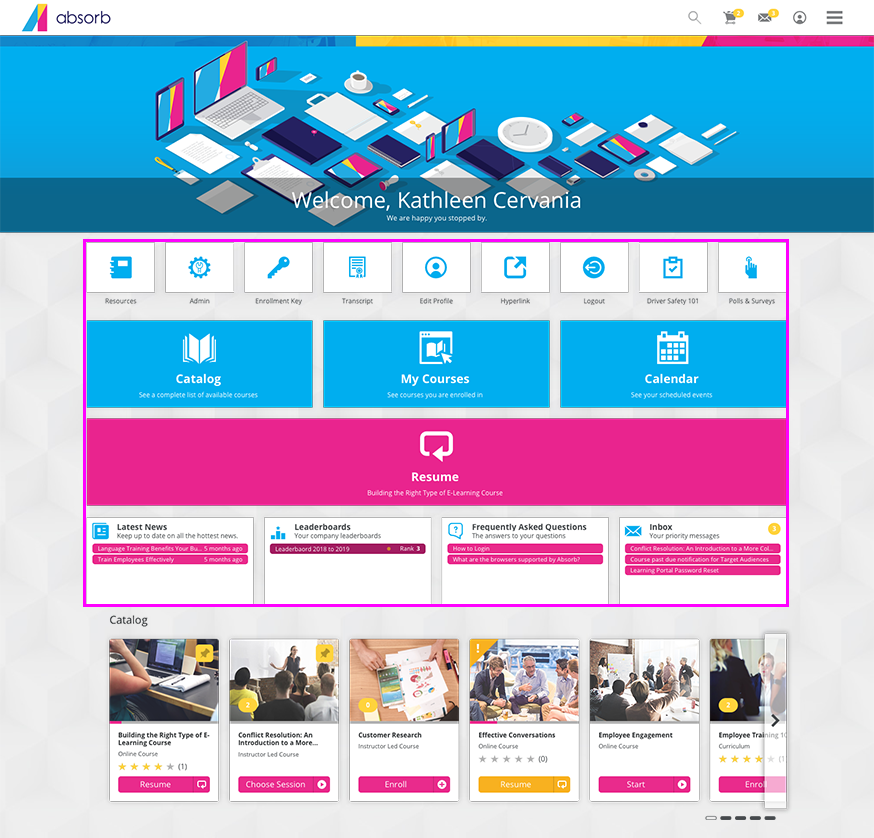
Absorb LMS is a game-changer for enterprises seeking to tackle complex training needs. This AI-powered LMS caters to industries across the board, enabling the effective training and upskilling of employees, customers, partners, and members globally. From compliance training to business growth and content monetization, Absorb LMS ensures a high return on investment (ROI) in learning.
My experience with Absorb has been exceptional. It seamlessly adapts to various learning requirements while being scalable and flexible. Absorb LMS is designed to future-proof your learning needs, whether you’re a large enterprise or a small to mid-sized business.
Standout Features of Absorb LMS:
- The Absorb mobile app allows learners to access materials anytime, anywhere
- Ensure data security with robust cloud security protocols, including GDPR compliance
- Enhance learner engagement with gamification tools like leaderboards, badges, and social learning features
What You Will Like:
- Create custom learning paths using AI to cater to each learner’s unique needs
- Get detailed reports and actionable insights to track progress and effectiveness
- There are API connectors, and the tool supports SCORM, xAPI, and HTML5, ensuring smooth integration with other systems
- Ensure your organization complies with industry standards through reliable and comprehensive training modules
What You May Not Like:
- The search field on the live site should offer additional filtering options
- Resources are displayed, but they are not accessible when clicked
- Timestamps should be added to videos before marking them as complete
Pricing: Custom pricing
User Rating: 4.5/5
3. Docebo – Best for Complex Enterprise Training
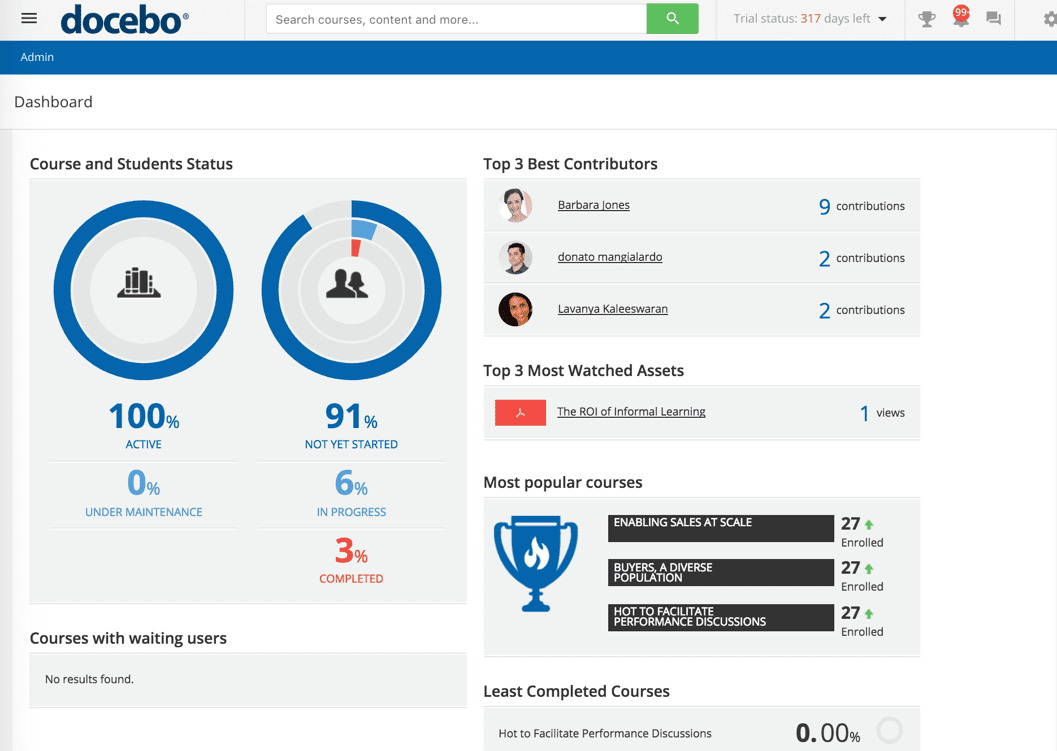
Although I haven’t used Docebo, my peers have raved about its capabilities, especially for large enterprises. Docebo is a global, AI-powered learning platform that meets complex training needs. Whether onboarding new employees, compliance training, or upskilling the workforce, Docebo provides a solid foundation for learning and development.
This is one of the best LMS cloud solutions that leverages AI to enhance content production, automate workflows, and improve learner experience. With over 30,000,000 global learners and 3,800+ companies on board, it’s clear that Docebo is a leader in the LMS market.
Standout Features of Docebo:
- Create custom reports and dashboards that deliver actionable insights to decision-makers
- Simplify user and admin interactions with an intuitive interface to promote faster adoption and reduce training overhead
- Use AI to enhance content creation and deliver personalized learning materials based on user behavior
What You Will Like:
- Excellent eCommerce capabilities, like coupon management and secure payment options
- Docebo allows for extensive customization of learning portals to reflect your company’s branding and identity
- Supports a mix of online and offline learning, allowing for a versatile training approach
- The Docebo mobile app ensures that learners can access training materials on-the-go
What You May Not Like:
- The webinar integration is unreliable, often failing without warning and causing frustration for users, with little support to fix the issues.
- Bugs in user and notification management take up a lot of time
- The admin setup is confusing, with essential functions hidden in menus and limited help in the Knowledge Base
Pricing: Custom pricing
User Rating: 4.4/5
4. LearnUpon – Best for Delivering Impactful Training
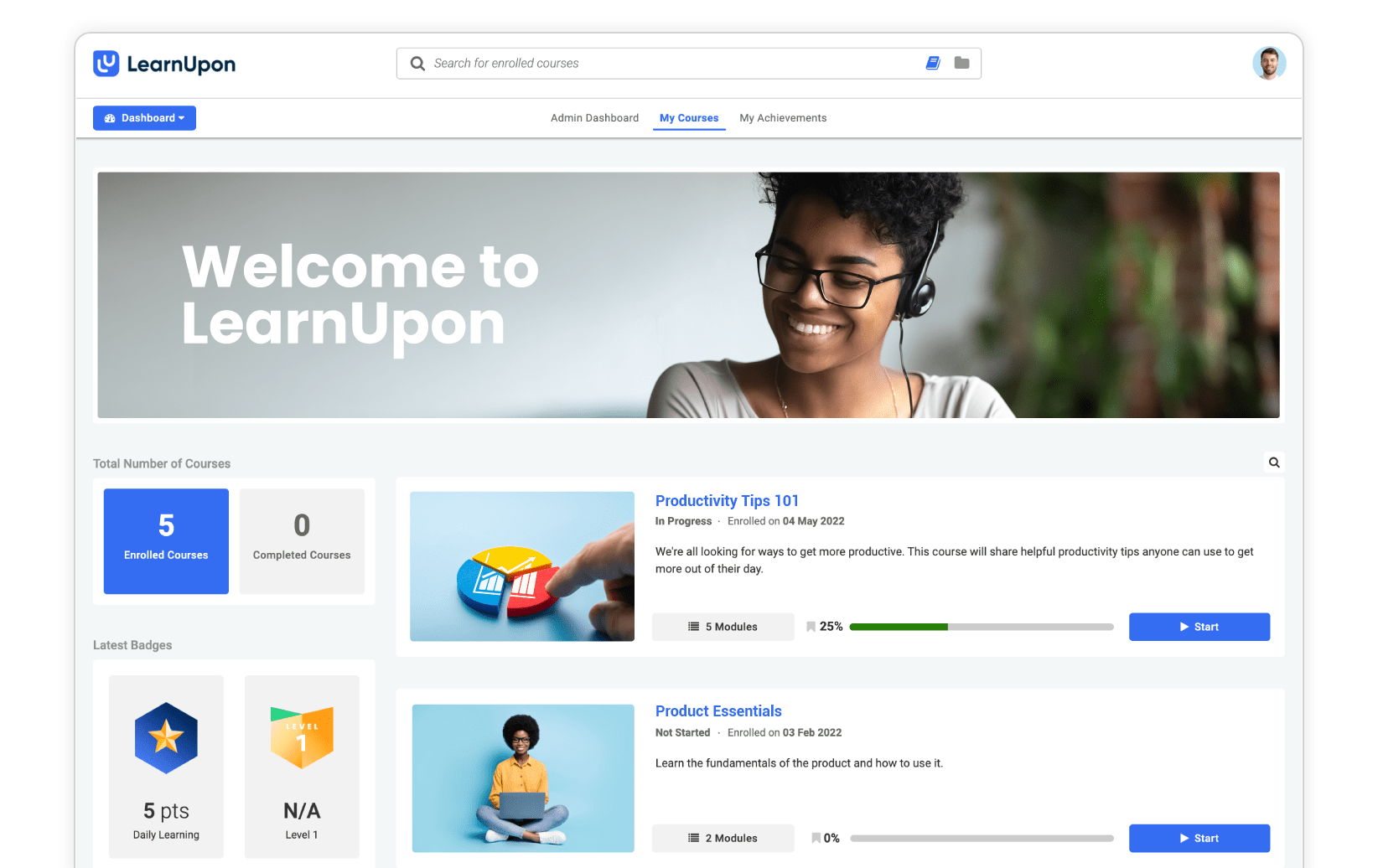
Designed for competitive advantage, LearnUpon combines powerful management tools with engaging learning experiences. It’s used by over 1,500 customers, including big names, and is celebrated for its ability to streamline employee training, from onboarding to compliance and continuous development.
The platform focuses on reducing admin workload by automating enrollments and guiding employees through structured learning paths. It also promotes self-serve learning, which enables employees to enroll in courses that cater to their career growth and curiosity.
Standout Features of LearnUpon:
- Manage training for external users, such as customers or partners
- Create branded, personalized training environments for different user groups
- Automate the delivery of courses and assessments to improve efficiency and reduce manual intervention
What You Will Like:
- Helps your new hires get up to speed quickly, with a 50% reduction in time to proficiency
- Guides employees through essential courses, ensuring they complete necessary training in an organized manner
- You can automatically enroll, test, and certify your employees, keeping your organization always audit-ready
- Features like social learning and gamification keep employees motivated
What You May Not Like:
- There is no visual indicator when a learner is disabled, which makes it harder to spot unless you click on their profile
- Adding custom content to a learner’s Home page is not possible
- There’s no report that shows which keywords were searched, which yielded results, and which didn’t
Pricing: Custom pricing
User Rating: 4.8
5. Litmos – Best for Off-the-Shelf Training
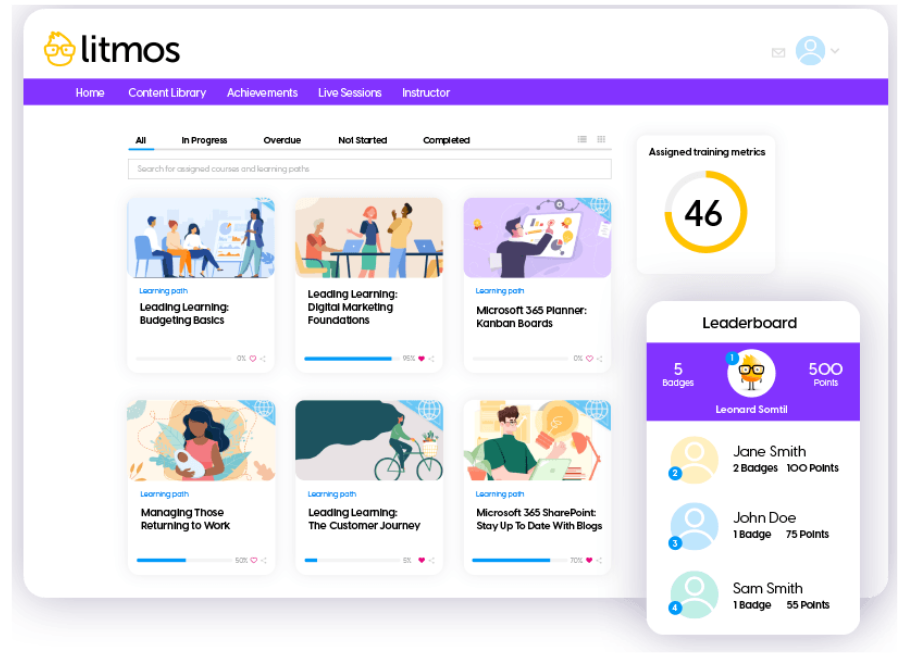
Litmos stands out in the LMS world with its extensive collection of off-the-shelf courses. The platform is designed to make training engaging and easy without compromising quality. With access to over 80,000 courses from leading providers like Go1 and Bigger Brains, Litmos ensures that your employees have a vast array of learning materials at their fingertips.
This LMS offers intuitive features like pre-built skills tagging, customizable learning paths, and seamless content integration. So, it’s one of the most powerful tools for any organization to enhance its training programs.
Standout Features of Litmos:
- Supports both in-person and virtual instructor-led training sessions for flexible learning
- Automatically generates personalized learning playlists based on learner behavior and needs
- Ensures learners can access training content on-the-go, through a fully optimized mobile app
What You Will Like:
- Tailored learning paths to meet the specific needs of your organization
- The diverse range of topics and engaging formats keep learners interested and motivated
- Courses are immediately available for use in any LMS, minimizing downtime and maximizing training impact
- Give your employees the access to supplemental materials such as handouts, workbooks, and more
What You May Not Like:
- The file size limit of 1 GB for most modules feels restrictive, especially when using video content
- Customizing the platform’s branding could be more user-friendly, as not everyone is familiar with HTML or coding
- While Litmos offers a good range of content creation options, there’s always room for more features to create and present content
Pricing: Custom pricing
User Ratings: 4.2
6) 360Learning – Best for Collaborative Learning
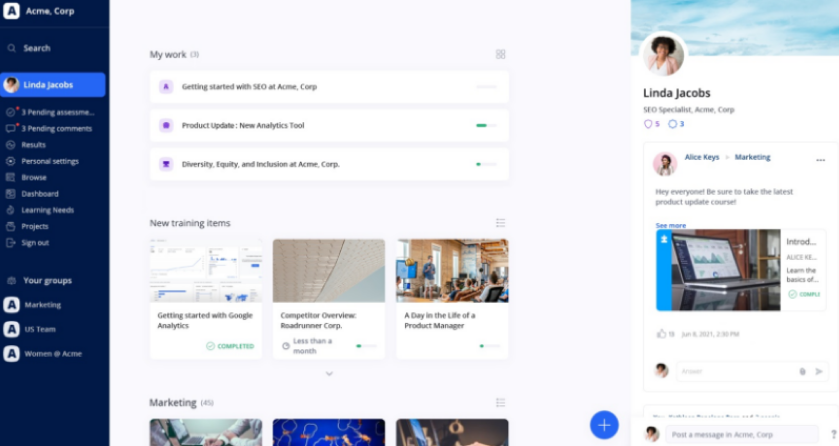
I recently had the opportunity to use 360Learning, which has revolutionized my learning management experience. This powerful tool handles all the tedious administrative tasks, such as user management and enrollment. With features like group projects, peer feedback, and real-time collaboration tools, 360Learning creates a dynamic learning environment.
Its social learning capabilities, combined with robust analytics and engagement metrics, make it the go-to LMS for organizations aiming to facilitate effective and engaging collaborative learning journeys. The tool also offers various integrations with popular business systems such as HCM/HRIS, Salesforce, MS Teams, and Zoom.
Standout Features of 360Learning:
- Prompt-based course builder powered by AI, which allows you to create training content with minimal input
- Single sign-on integrations with platforms like Microsoft and Google for a seamless, secure login experience
- Multilingual support for managing global training with automatic translation and adaptive language features
What You Will Like:
- Supports AI-based training creation to save time and effort
- You can streamline administrative tasks to reduce manual workload
- It facilitates seamless user integration to leverage existing user data without manual data entry
- Easy to navigate, making it accessible and straightforward
What You May Not Like:
- Lacks options for tracking and managing Cloud-based LMS certifications
- Uploading files and embedded links is not always simple
- The search field needs improvement for better filtering options
- Need adjustments in assigning programs to provide more control over scheduling
Pricing: Starts at $8/user/month
User Ratings: 4.6
7) iSpring Learn – Best for eLearning and Training
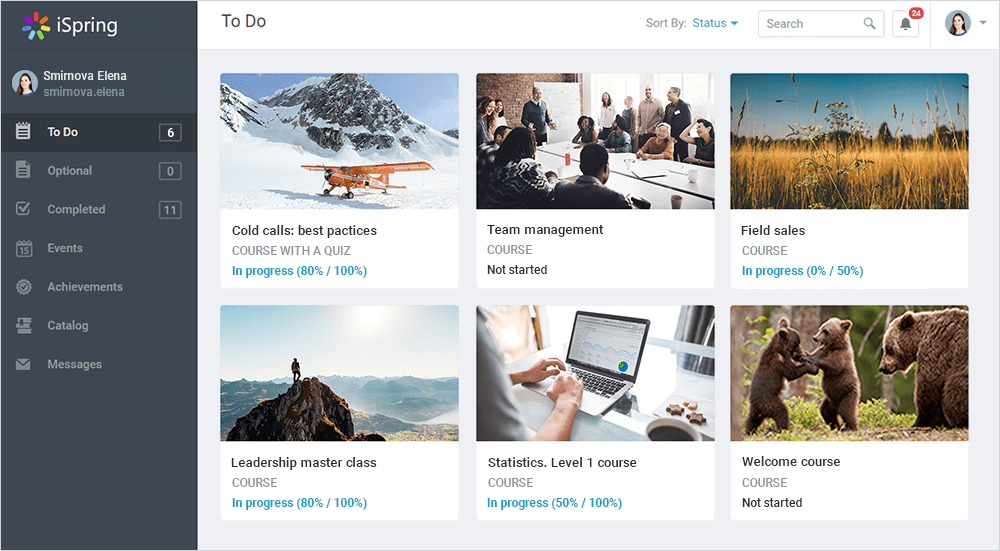
I have been using iSpring Learn, and it has been an incredible cloud-based learning system for our employee training needs. With its comprehensive features, including content authoring, tracking, and reporting, iSpring Learn offers a seamless and efficient platform for delivering and managing corporate training programs. One specific use case where iSpring Learn has made a significant impact is in our new hire onboarding process.
As one of the best cloud LMS systems, it helps create engaging and interactive onboarding courses that effectively introduce our new employees to our company culture, policies, and job responsibilities. The platform’s intuitive course creation interface has made it easy for me to develop captivating courses for corporate training programs. Assigning training content to employees has been a breeze with iSpring Learn. I can easily select the specific teams or individuals who need to complete the training and set deadlines for completion.
Standout Features of iSpring Learn:
- Offers a constantly expanding library of LMS-ready courses from iSpring Academy
- Employees can access training from any device, both online and offline, using the iSpring Learn app
- iSpring offers tools like iSpring Quiz Maker for creating quizzes and assessments
What You Will Like:
- Ability to create combined video and PowerPoint presentations
- Allows you to convert PowerPoint presentations into SCORM-compliant courses
- iSpring Learn supports SCORM and HTML5, ensuring compatibility with various eLearning standard
- It comes with an in-built screen recording tool
What You May Not Like:
- Template storage and reuse could be better
- Text search feature in presentation needs improvement
- SSO does not support the latest standards
Pricing: Starts at $2.29/user/month
User Ratings: 4.7
8) Seismic Learning – Best for Training Sales Team
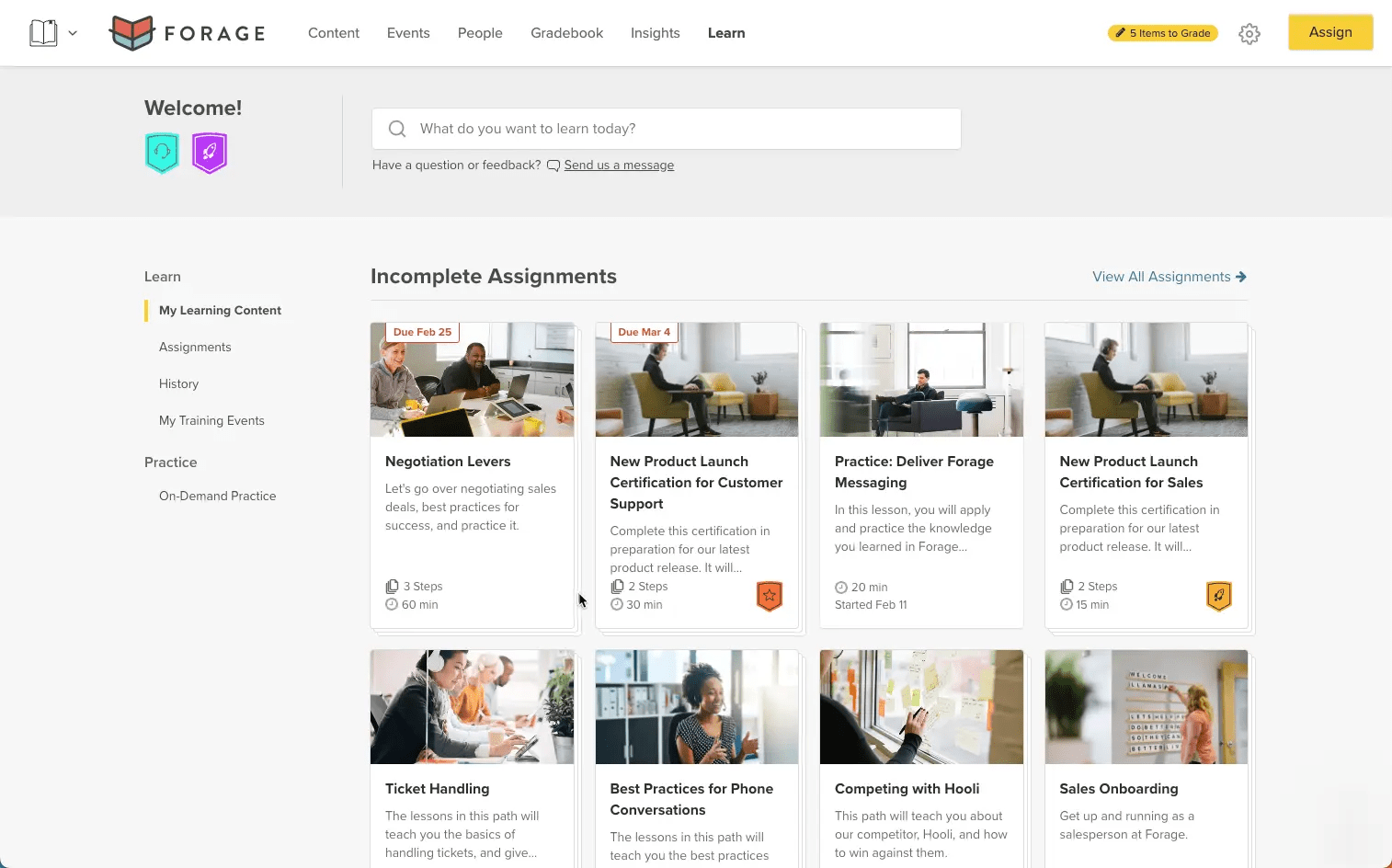
If you’re looking to level up your sales team’s training, Seismic Learning might just be the answer. Every time your reps are about to connect with a prospect, they’ve got the exact content they need – thanks to Seismic’s powerful platform. What I appreciate more about this cloud LMS is that it offers on-demand modules that fit right into a busy sales schedule so your team can boost their skills without skipping a beat.
Plus, with real-time insights and content suggestions, your sales reps know they’re always on top of the latest product updates and customer data. Think of it as giving your team the confidence to close deals and engage customers precisely—all backed by tools that track performance and pinpoint what’s working. Seismic helps drive real results by turning knowledge into action.
Standout Features of Seismic Learning:
- Automates content creation and distribution to ensure the right materials reach the right audience at the right time
- LiveDocs enables teams to customize documents and sales materials in real-time
- Integrates with Microsoft, Salesforce, and other CRM tools to increase workflow efficiency
What You Will Like:
- Get quick access to personalized sales content whenever your team needs it
- Flexible, on-demand learning that adapts to each rep’s pace and schedule
- Real-time performance insights that make it easy for you to track progress
- Seamless CRM integration to keep everything in one place
What You May Not Like:
- Lacks self-serve support resources for independent troubleshooting
- Limited audio capabilities, which may impact the training variety
- Text editing features could be improved for smoother content creation
Pricing: Custom pricing
User Ratings: 4.6
9) Moodle – Best for Open Source Learning
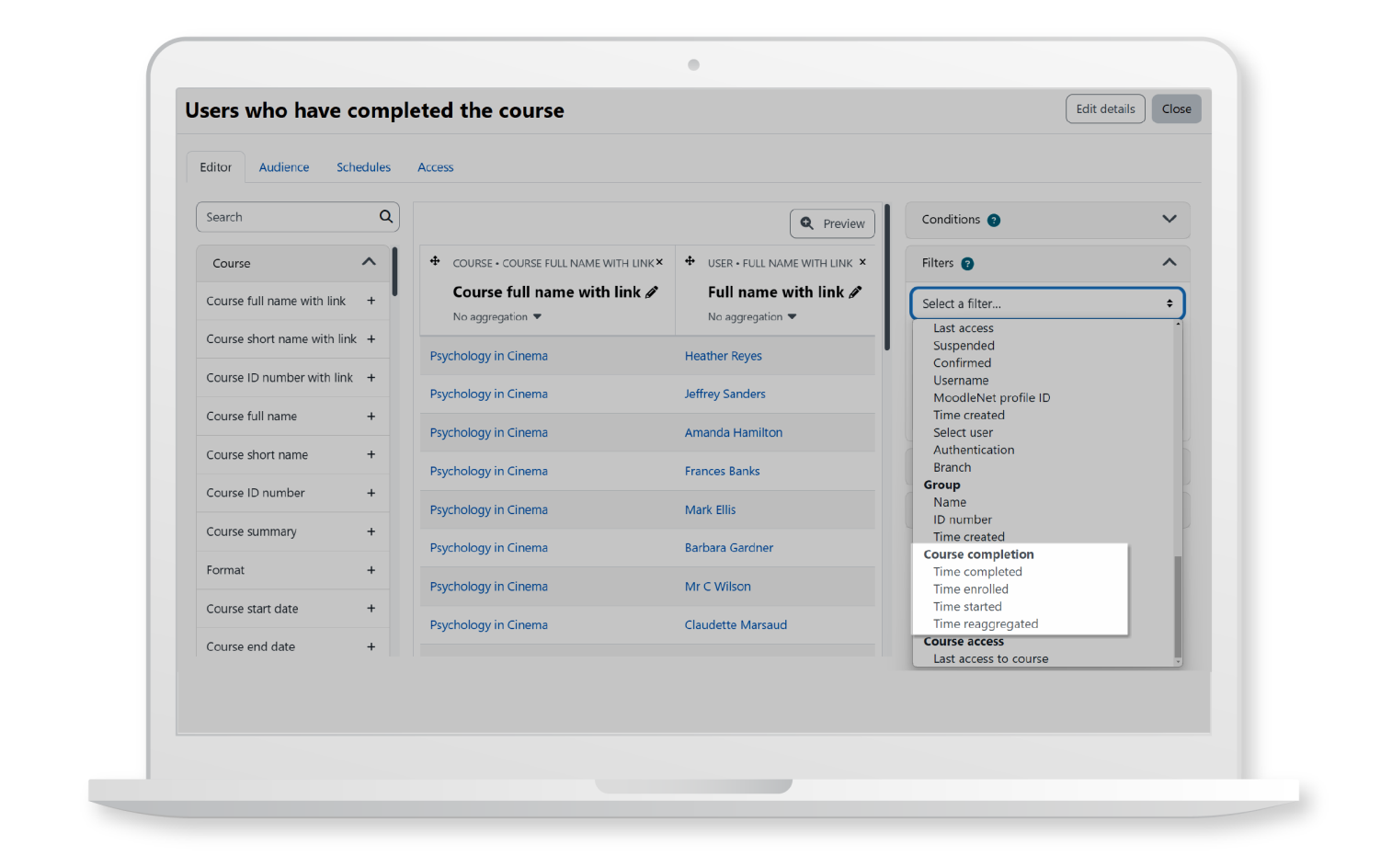
Moodle LMS, in my experience, is an exceptional cloud LMS that offers personalized and engaging eLearning experiences. Whether you’re in K-12 classrooms or multi-campus universities, Moodle provides a flexible and feature-rich platform to meet the diverse needs of learners now and in the future.
Moodle’s main USP is its fully customizable nature. You can easily modify its source code and tailor the platform. You have the freedom to create and edit courses and deliver content and tasks in various formats to accommodate different learning environments. The platform integrates with content accessibility checkers and text-to-speech tools to accommodate diverse learning needs and ensure everyone can access the learning materials.
Standout Features of Moodle LMS:
- Facilitates the creation of custom organizational structures based on the size and requirements of the business
- Integrates with external software and content management systems for a unified learning experience
- Quick setup and implementation ensure a smooth transition to a new learning management system
What You Will Like
- Allows for flexible teaching and learning, accessible anytime and anywhere
- It provides tools to measure and manage learner progress through detailed reports
- Text-to-speech tools are available, enhancing accessibility for learners
- It supports the delivery of learning materials in various formats
What You May Not Like
- Integration with third-party software is limited, hindering seamless workflow
- Scheduling management could be improved for better organization
- The mobile version requires further development to enhance the usability
Pricing: Free tool as it’s open source platform. The paid plan starts at $131/year (for 50 users)
User Ratings: 4.3
10) SkyPrep – Best for Online Training & Employee Development
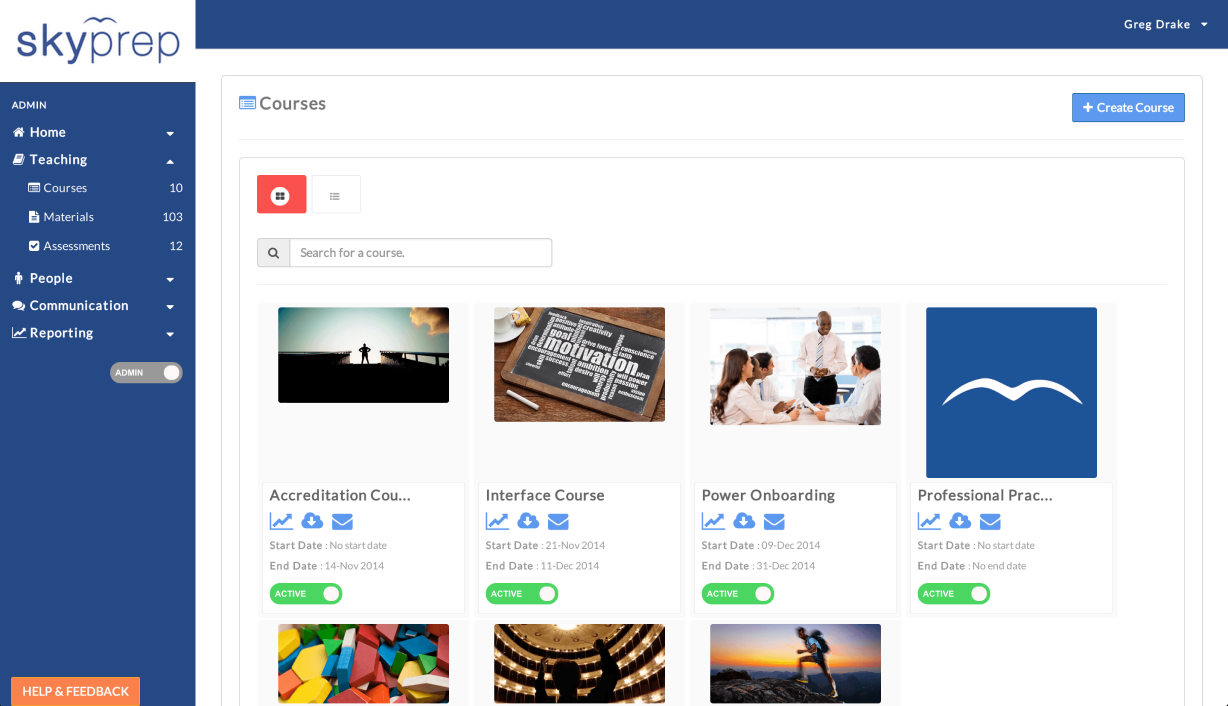
SkyPrep is a great LMS designed to make training impactful and user-friendly. It streamlines every step, from creating courses to analyzing outcomes, so training translates into real business value. With an intuitive interface and engaging tools like gamification, SkyPrep turns learning into a more interactive experience.
The platform allows for custom branding and multi-tenant management and offers workflow automation. Built-in integrations with tools like Zoom and Google enhance its adaptability to existing business setups. Plus, SkyPrep’s robust security measures ensure your data remains protected at all times.
Standout Features of SkyPrep:
- Organize your content into chapters and sections for better structure and easier navigation
- Optimized for use on any device—desktop, laptop, tablet, or mobile
- Design custom quizzes with a variety of question types (e.g., mix and match, true/false, short answer)
What You Will Like:
- Straightforward course creation with options for assessments and knowledge checks
- Fully customizable branding to keep your LMS on-brand
- Automation features that reduce repetitive tasks and boost efficiency
- Compatibility with popular tools like ADP and Google to fit seamlessly into workflows
What You May Not Like:
- The platform struggles with handling large files or content-heavy courses
- It lacks robust options for alerting learners about course deadlines or updates
- Navigating through courses, especially when following a set order, is not as smooth or intuitive as expected
Pricing: Custom pricing
User Ratings: 4.8
Cloud LMS vs On-Premise LMS: Key Differences
The choice between cloud-based and on-premise LMS isn’t just about technology; it’s about how you want to run your business.
I’ve helped dozens of companies make this decision, and the differences are stark. Let me break down what really matters.
Cost Structure: Upfront vs Ongoing
Cloud-Based LMS:
- Monthly subscriptions typically range from $5 or less per learner per month
- No hardware or installation costs
- Predictable monthly expenses that scale with your team
- Automatic updates included in your subscription
On-Premise LMS:
- Licensing fees generally range from $500 to $20,000, and setup can cost over $25,000
- Server hardware, software licenses, installation costs
- Ongoing IT staff salaries and maintenance contracts
- Surprise upgrade costs every few years
Scalability: What Happens When You Actually Grow
When your team grows from 50 to 500 users, the differences become critical and expensive.
With on-premise systems, scaling takes months of planning. You have to buy more servers, purchase additional licenses, and possibly hire more IT staff. Worse, you have to guess future capacity. Underestimate it, and your system crashes. Overestimate it; you waste money on unused resources.
I’ve seen companies spend weeks planning to expand by 100 users, only to face system downtime during the migration. Training stalls. Productivity suffers.
Cloud-based LMS platforms scale instantly. You add users as needed and only pay for active ones. If team size shrinks, you’re not stuck with unused licenses. Flexibility is built in.
Maintenance: Who Fixes Things When They Break
On-premise LMS systems make every technical problem your responsibility. Security patches, software updates, system crashes — you fix them or pay someone who does. Every hour your IT team spends on LMS upkeep is an hour lost from core business work.
Cloud LMS providers handle maintenance for you. Dedicated teams monitor the system 24/7. When problems occur, they fix them—often before you notice. Most providers guarantee 99.9% uptime, backed by service credits if they fall short.
Access: Where Your People Actually Work
Legacy systems were built for office-based work. Remote access typically means slow VPN connections and IT bottlenecks. Field staff and remote employees struggle to complete training. This leads to compliance gaps and lower completion rates.
Cloud LMS platforms are built for modern workforces. Employees access training via a browser or mobile app, anytime, anywhere, without VPNs or IT tickets. Training happens when it’s convenient, so it gets done.
Security: Professional vs. DIY Protection
Running security in-house sounds safer, but it’s usually not. Managing on-premise security means handling threats, patches, firewalls, and regulatory compliance yourself—an expensive and complex task.
Cloud LMS vendors invest millions in enterprise-grade security. Dedicated security teams monitor threats 24/7 and roll out protections across all customer data centers. Data is also stored across multiple locations, reducing risk from hardware failures or disasters.
Integration: Connecting Your Tools
On-premise LMS integrations typically require custom development. Connecting your LMS to Microsoft Teams, Zoom, or CRM systems becomes a series of costly, time-consuming IT projects. Each update risks breaking your setup.
Cloud LMS platforms offer pre-built integrations with popular business tools. Connecting to Azure AD, Zoom, Slack, or your CRM usually takes minutes. When those tools update, your LMS integrations stay intact automatically.
Why This Matters for Your Decision
An on-premise LMS puts the entire burden on your team—from buying and managing servers to handling security, updates, and late-night outages.
A cloud-based LMS lifts that load. The provider takes care of the infrastructure, security, and maintenance. You get a platform that’s always ready to use, so you can focus on what really matters: creating and delivering training.
| Factor | On-Premise LMS | Cloud-Based LMS |
|---|---|---|
| Setup Time | 3-12 months | Same day |
| Upfront Cost | $50,000-$500,000+ | $0-$500 |
| Monthly Cost | High (IT staff + maintenance) | $3-$25 per user |
| Scalability | Complex, expensive | Instant, automatic |
| Mobile Access | Limited, clunky | Native, optimized |
| Updates | Manual, disruptive | Automatic, seamless |
| Security | Your responsibility | Shared, professional |
| Compliance | DIY | Built-in certifications |
How to Choose the Right Cloud LMS (And What Features Actually Matter)
So now you know why cloud beats on-premise. Next comes the real challenge: choosing the right LMS for your business.
I’ve seen too many companies buy the wrong tool, chasing flashy features, ignoring actual needs, and paying for complexity they never use. Here’s how to avoid those mistakes.
1. Start With Your Real Training Needs
Before you get wowed by AI course builders or gamification badges, ask three simple questions:
- What type of training matters most?
Compliance? Sales enablement? Skills development? Each needs different LMS strengths.
- Who are you training?
Internal teams? Customers? Partners? Different audiences = different feature needs.
- How do they learn?
Mobile-first? Desktop-heavy? Choose an LMS that matches your team’s reality, not vendor promises.
2. Course Creation Speed
If your LMS makes it hard to build courses, adoption will stall fast. You need a platform that helps you get training content live quickly, without a dedicated eLearning team.
The best platforms let you:
- Start with pre-built templates tailored to your industry
- Import existing content (PDF, PPT, SCORM) seamlessly
- Build courses using a simple, no-code editor your team can manage
3. User Experience That Drives Engagement
Even great content falls flat if the LMS is painful to use. Learners expect a smooth experience—they won’t fight bad UX to finish training.
- Pay close attention to whether the platform offers:
- Single sign-on with the tools your team already uses
- Clear progress tracking and intuitive dashboards
Mobile apps that feel fully native, not stripped-down versions of the desktop experience
4. Reporting That Shows Real Impact
It’s not enough to track completions. You need reporting that helps you prove training ROI and improve outcomes.
Strong reporting should give you:
- Completion rates segmented by team, role, or location
- Time-to-completion insights that flag bottlenecks
- Assessment reports that reveal knowledge gaps
- Cost-per-learner and ROI tracking that informs future investments
5. Integration Capabilities
Your LMS shouldn’t be a silo. It should connect smoothly with your existing business tools to simplify workflows and improve data visibility.
Look for deep, ready-to-use integrations with:
- HRIS tools (for automatic user provisioning)
- Zoom/Teams (for managing live training sessions)
- CRM platforms (for customer and partner training programs)
- Business intelligence tools or APIs (for advanced reporting and analysis)
6. Scalability Without Surprises
An LMS should scale with you, not become a liability as your training needs grow. Many platforms seem affordable at first, but costs and limitations surface as you add users or expand features.
To avoid surprises, make sure the LMS offers:
- Transparent, predictable pricing at every user tier
- No arbitrary feature restrictions at higher levels
- A proven track record supporting large organizations
- Flexible user and group management that won’t break as your team scales
Get Free LMS Software — All Features, Forever.
We've helped 567 companies train 200,000+ employees. Create courses in under a minute with our AI LMS or use 200+ ready-made courses on compliance, harassment, DEI, onboarding, and more!
Making the Final Decision
Use this simple scorecard to pick your LMS:
| Criteria | Score (1-10) |
|---|---|
| Ease of Use (for both admins and learners) | |
| Feature Fit (does it do what you actually need) | |
| Total Cost (including hidden costs and admin time) | |
| Support Quality (based on your evaluation experience) | |
| Growth Potential (will it work as you scale) |
11 Reasons Smart Teams Switch to Cloud-Based LMS Platforms
Using a cloud-based LMS offers more than convenience. It helps businesses deliver training faster, reduce costs, and support a modern, flexible workforce. Here are the key benefits you can expect:
- You can launch new training content quickly across the organization without waiting for IT involvement or manual updates.
- Employees in office, remote, and field environments can easily access the same training through a web browser or mobile app.
- You avoid large upfront investments in servers and IT staff, and your LMS costs scale predictably based on usage.
- Security and data protection are built in, with encryption, automated backups, and compliance with standards like GDPR and HIPAA managed by the LMS provider.
- The platform automatically delivers new features and improvements without the need for manual software upgrades or downtime.
- Your internal IT team can focus on more strategic work instead of spending time maintaining or troubleshooting training systems.
- You can easily onboard and offboard users as your team changes, with automated user management and flexible licensing.
- Built-in templates and content creation tools help non-technical staff quickly create engaging courses, reducing reliance on specialized eLearning teams.
- The LMS is accessible and user-friendly even for non-technical audiences like volunteers, field workers, or external partners.
- You can extend training beyond employees, easily supporting partners, customers, and other external learners through flexible user management.
- Cloud-based systems typically offer clearer data export and portability options, reducing vendor lock-in and making future migration easier.
Are You Ready to Choose the Right Cloud LMS Solution?
As I mentioned earlier, there’s no such thing as the “best” LMS. But there is definitely a right LMS for you. Choosing the wrong system can result in a huge waste of time and money. Think about it: an LMS that doesn’t align with your needs can lead to poor employee engagement, lower productivity, and ineffective training. The financial toll? It’s real. You could end up spending more on system maintenance, underutilized features, or even the cost of switching to a better system later on. This all impacts your ROI and slows down your business growth.
The key is to make an informed decision. You need a system that fits your goals, is easy to use, and provides long-term value. But choosing the right LMS isn’t as simple as picking one off a list. It’s a process that involves understanding your specific needs, assessing your options, and weighing the risks.
So, the big question is: How much are you willing to risk to get it right?
Frequently Asked Questions
What is the difference between a cloud-based LMS and a hosted LMS?
A cloud-based LMS is a subscription service hosted on third-party servers with no need for local infrastructure. A hosted LMS runs on a dedicated server on the company’s premises or through a third-party provider.
Is a cloud-based LMS secure?
Yes, a cloud-based LMS can be secure if it follows industry-standard security practices like encryption, regular updates, secure backups, and access control. Ensure the provider complies with data privacy regulations (e.g., GDPR, HIPAA).
How much does a typical cloud LMS cost?
The cost of a cloud LMS depends on factors like the number of users, features, and customization. Typically, prices range from $1.99 to $15 per user per month, with enterprise-level systems costing more.
Can I migrate my existing data to a cloud LMS?
Yes, you can transfer your training content, user data, and reports to the new system and seamlessly upload previous training content, course materials, and user information. ProProfs Training Maker offers a user-friendly interface and support to ensure a smooth data migration process.
How do I measure the success of my LMS implementation?
Measure success by tracking user engagement, course completion rates, learner performance, and feedback. Also, evaluate how well the system meets business goals like improving productivity, reducing training costs, or increasing employee satisfaction.


 We'd love your feedback!
We'd love your feedback! Thanks for your feedback!
Thanks for your feedback!








